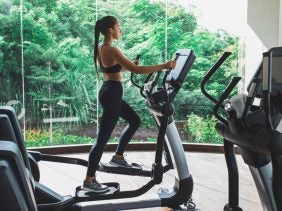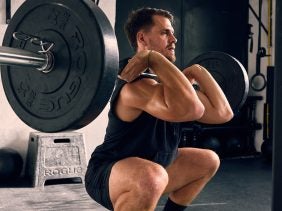Upper Body Workout For Men: The best tips & exercises
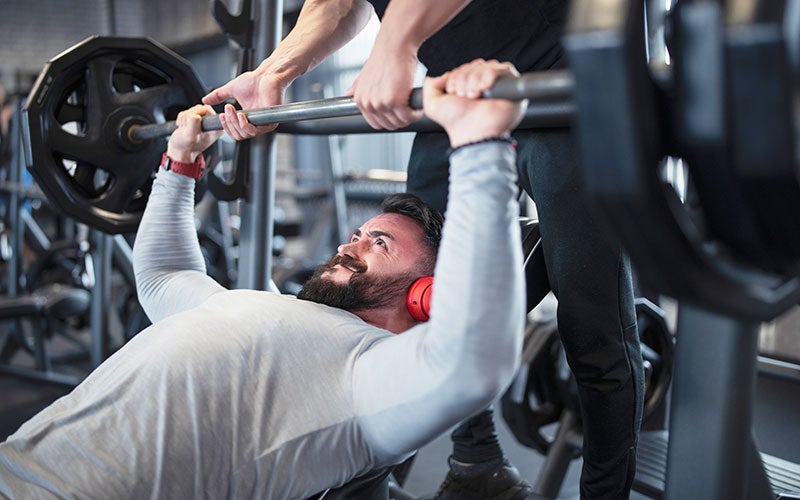 ©ArtistGNDphotography
©ArtistGNDphotography
Want to get broad shoulders, a steel-hard chest, muscular arms, and a visible six-pack? Let’s get to work! Learn everything you need to know about your new upper body workout for men – with the most effective exercises for the gym and at home!
Upper Body Muscles at a Glance
The upper body muscles include your arms, shoulders, chest, back, and abdomen. The number of major muscle groups to be trained is relatively large. Biceps and triceps play a decisive role in upper body workouts, but the deltoid, rotator cuff, pecs, and lats are also important because they’re responsible for that Instagram-able V-shape. Last but not least, there’s the abdominal muscles that give you that impressive six-pack.
Here are the most important upper body muscles at a glance:
- Triceps (M. triceps brachii): Your triceps extends the elbow joint.
- Biceps (M. biceps brachii): Your biceps flexes the elbow joint.
- Pectoral muscles (M. pectoralis major): Your pecs support your arms and breath.
- Lats (M. latissimus dorsi): Your lats have the largest surface area of all the muscles in your body. They extend from the arm through the thoracic and lumbar vertebrae to the sacrum and ilium.
- Shoulder and neck muscles (M. trapezius, M. rhomboideus, M. deltoideus): The deltoids (deltoideus), the traps (trapezius), and the rhomboid muscles (rhomboideus) stabilize your shoulder blades and straighten your upper spine.
- Rotator cuff (M. infraspinatus, M. supraspinatus, Musculus subscapularis, Musculus teres minor): The rotator cuff is responsible for stabilizing the shoulder joint.
- Abdominal muscles (M. obliquus externus abdominis, M. rectus abdominis): The straight and lateral abdominal muscles stabilize, flex, and rotate the trunk.
- Forearm muscles: The muscles in your forearm are the foundation for your grip strength, which is what you need, for example, if you want to work on pull-ups.
Upper Body Workout Benefits
A broad back, lean muscle mass, and sculpted arms are part of the fitness goals for many men. A nice side effect: larger chest and arm muscles immediately make your belly look much smaller.
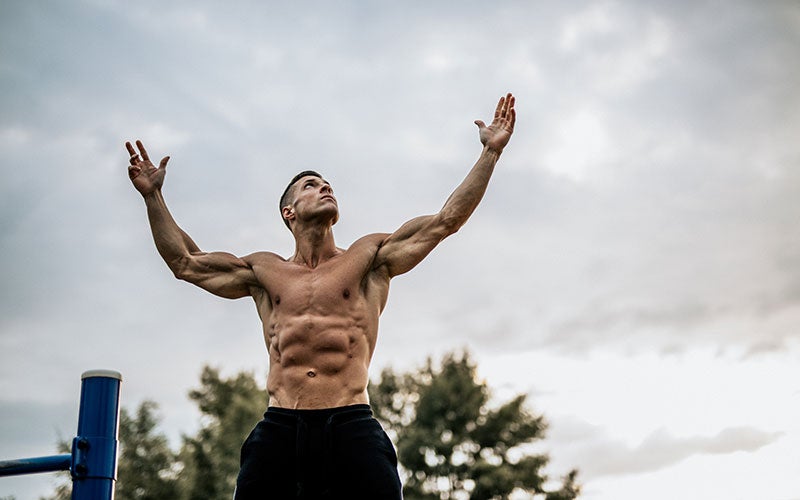
Regular upper body workouts also have health benefits: A well-toned musculature can compensate for postural weaknesses and imbalances as well as protect the joints. The shoulder muscles in particular, but also the spine, are susceptible to injury. Strains, tension in the neck area, and back pain can be prevented if your upper body is strong enough.
Working a lot at a desk or sitting for several hours a day isn’t as stressful for your body if you have a strong lower back. Plus: carrying heavy loads is easy peasy if you keep up your upper body strength.
Last but not least, well-developed upper body muscles give you an advantage in many sports. Whether it’s martial arts or a ball sport, yoga or long-distance running, well-trained arms and core muscles can really improve your performance in handstands, planking, throwing, dribbling, cardio, and boxing.
What is Important in Upper Body Workouts for Men?
Think that as long as you’re lifting weights or constantly hogging the pull-up bar, all your muscles will just grow by themselves? It’s not that simple! If you want to achieve sustainable results, pay attention to the following points:
- The shoulder joints and lower back are especially prone to injury. Start every workout with a warm-up to get all of your body parts moving. Good exercises for this include arm circles and warm-up sets with light weights.
- Always pay attention to proper form, because it’s much more important than weight and number of repetitions. Start any new upper body exercise with just your own body weight, or lighter weights than you’re used to.
- If you’re a beginner, integrate your upper body workout routine into a full body workout first.
- Organize your workouts from big muscles to small. This means working your abdominals, back, and chest muscles first, then your arms and shoulders. In a full-body workout, start with your lower body first.
- If you’re an advanced athlete working with a split training plan, reserve one session for your back and chest muscles, one for biceps, triceps, and shoulders, and a third for abdominals, back, and lower body.
- New training stimuli are necessary for muscle growth so make sure you have enough variety with body weight, cable pulley, and barbell and dumbbell exercises.
- If you want to see progress quickly, two training sessions per week are a good idea. Defined muscles also require sufficient regeneration time and a combination of enough sleep, active rest, and the right nutrients, with our Recovery Aminos for example.
- If you want to build upper body strength, a diet high in protein and carbs is an essential component of your fitness plan. Make sure your meals are varied and balanced.
Nutrition Plan for Muscle Building
7 Upper Body Exercises
Ready to hit the weights? Then it’s time to get started! Here are our 7 best upper body exercises to do at home or at the gym:
#1 Bench Press with Barbell
Lie on your back on a workout bench. The barbell rack should be at your eye level. Press your feet firmly into the floor and grab the barbell. In this starting position, your forearms and upper arms should form an approximately 90-degree angle. Build up tension in your abdomen and lower back so your lumbar curve is stabilized. At the same time, pull your shoulder blades back to stabilize your shoulder joints. Lift the barbell from the rack and then lower it to your chest with control. Hold briefly and press the barbell back up steadily. Arms remain minimally bent. Once you reach the top position, bring the barbell right back down to the start position for another rep.
Alternative: Use two dumbbells to do the bench press.
#2 Pull-ups
Grab the pull-up bar shoulder-width apart in an overhand or underhand grip and let your body hang down first. Keep your arms straight up from your shoulders and your muscles should be relaxed. Keep your gaze straight ahead. This is a passive hanging position: To switch into active hang, fix your shoulder blades by pulling them down your back. Your upper body should already be moving up a little. Tighten your abdominals and glutes and pull yourself upward with the strength of your biceps and upper back until the bar is level with your sternum. Hold this end position briefly and then lower yourself back down with control. Keep your body straight and your core braced. Once you reach the active hang position again, switch to passive hang and start your next rep.
#3 Push-ups
Start in a high plank position. Place your hands slightly wider than shoulder-width. Slowly lower your body until your upper arms are parallel to the floor. Hold this low position briefly and then push yourself back up. Keep your entire body engaged and your gaze directed towards the floor.
Alternatives: Advanced athletes can try push-ups on their fists or a one-armed variation.
#4 Military Plank
Start in a forearm plank: elbows below your shoulders, abdominals and glutes engaged. Now come up a level by placing first one, then the other hand palm down on the mat – until you are in high plank on your palms. From here, go down again step by step back into the forearm plank. Important: Always keep your hips parallel to the floor. Work slowly and consciously tighten your abs and glutes to maintain stability.
#5 Arnold Press
The ultimate exercise for your shoulders and neck: sit on a workout bench, and grab two dumbbells with your palms facing you. Like a Biceps Curl, bend your arms first and pull the weights toward your shoulders. Your torso stays upright, your lower back is slightly hollow and your shoulder blades are drawn toward your spine. Once the dumbbells are at shoulder height, rotate your wrists outward and press your arms above your head. Your palms should face forward in this end position. Hold this position for a moment and then bring the dumbbells back down with control.
#6 Biceps Curls
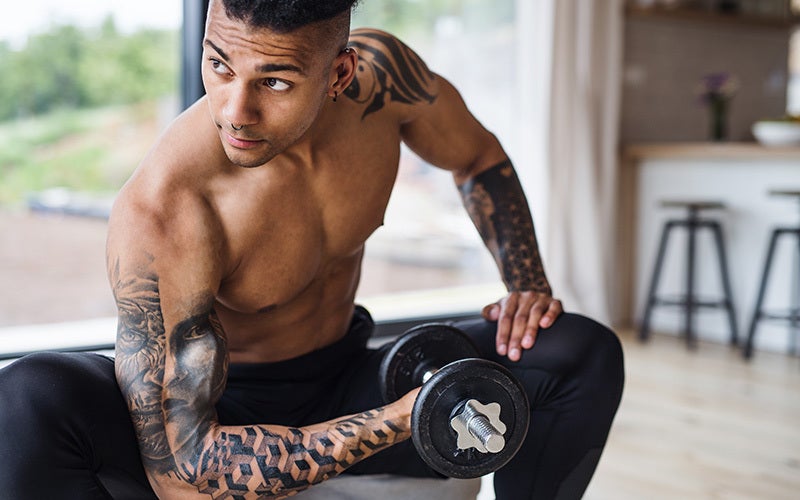
Grab two dumbbells with your palms facing you. Sit on a workout bench or stand with your feet hip-width apart. Roll your shoulders back and let your shoulder blades slide down your back. Anchor your elbows firmly at your waist. First extend your arms and briefly activate your triceps. Now bend your arms at the same time and lift the weights up to your shoulders. Hold the position briefly and lower the dumbbells back out to extension in a controlled manner.
#7 Triceps Extensions
Grab a dumbbell with both hands and extend your arms above your head with a slight bend in your elbows. Keep your arms close to the sides of your ears and point your elbows forward. While keeping your shoulders stable and tensing your triceps, bend both elbows and bring the dumbbell toward your neck without your upper arms changing position. Return to the starting position and repeat.
Conclusion
- An upper body workout for men specifically targets your upper chest, back, abs, arms, and shoulders.
- The right upper body exercises build up your back muscles, prevent joint problems, tension, or back and neck pain, as well as improving your performance in other sports.
- Two sessions per week are perfect for building strength. Make sure you vary the workouts and don’t over- or under-exert yourself.
- A warm-up, enough recovery time, and a diet are all important for keeping your upper body strong.
Sources for this article
We at foodspring use only high-quality sources, including peer-reviewed studies, to support the facts within our articles. Read our editorial policy to learn more about how we fact-check and keep our content accurate, reliable, and trustworthy.































